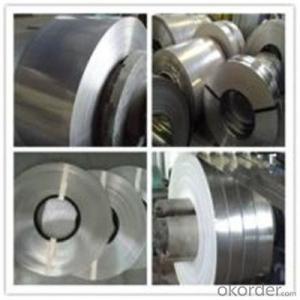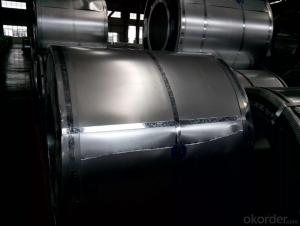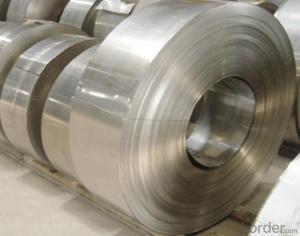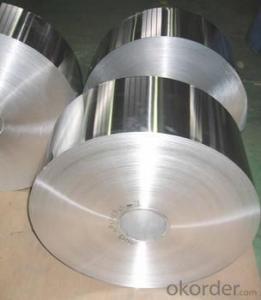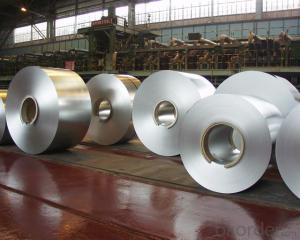Steel Strip Coils in Various Materials from China
- Loading Port:
- Qingdao
- Payment Terms:
- TT OR LC
- Min Order Qty:
- 33 m.t.
- Supply Capability:
- 1222665 m.t./month
OKorder Service Pledge
OKorder Financial Service
You Might Also Like
Item specifice
Description of Steel Strip Coils:
Steel strips is one of our main products that is widely used in making band saw blade & other blades to cut paper, weed, etc.
Festures of Steel Strip Coils:
1.Thickness: 0.14-3.0mm
2.width:30-600mm
3.zinc coating: 30-275g
4.material:Q195, Q235,SGCC, A653 CS-B, DX51D,SGCD,SGHC,S350GD,S450GD,S550GD
5.spangle: zero spangle, regular spangle, small spangle
Specifications of Steel Strip Coils:
1)Material:SPCC,SPHC,Q195,Q235,Q345,Q345B
2)Thick:0.15-3.0mm
3)Width:30-700mm
4)Zinc coating:Z6 to Z27(60g/m2 to 275g/m2, double sides)
5)Surface condition:Regular spangle
Images of Steel Strip Coils:
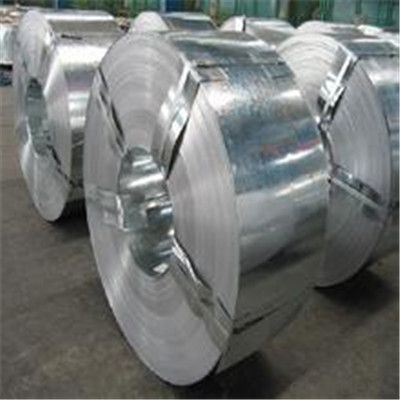
FAQ
1.What's your MOQ?
25MT, it is for one container.
2.Do you have QC teams?
Yeah, sure, our QC team is very important, they will keep the quality control for our products.
3. What's your normal delivery time?
Our delivery time about 10-20days for standard sizes, if you have other requirements like hardness and width ,it is about 20-40days.
- Q:How are steel strips used in the manufacturing of conveyor systems?
- Due to their strength, durability, and versatility, steel strips play a crucial role in the production of conveyor systems. These strips are an integral component used primarily for constructing conveyor belts, which are vital for transporting materials and products across various industries. To create the conveyor belt, the steel strips are typically shaped into a continuous loop and connected using various methods like welding or mechanical fastening. This looped structure serves as the foundation for the conveyor belt, enabling continuous movement and the ability to carry heavy loads without deformation or failure. The smooth surface of the steel strips ensures minimal friction and resistance during the conveyor belt's movement, facilitating efficient material handling. Additionally, the high tensile strength of the steel enables the conveyor system to handle heavy loads and endure the demanding conditions of industrial environments. Steel strips used in conveyor systems can be tailored to meet specific requirements, such as width, thickness, and surface finish. They can be manufactured with features like perforations or grooves to enhance grip and prevent material slippage. Furthermore, steel strips can be coated or treated to resist corrosion, abrasion, or extreme temperatures, increasing their longevity and performance. In conclusion, steel strips are indispensable in the production of conveyor systems as they provide the necessary structural integrity, strength, and durability for efficient material handling. These strips form the core of conveyor belts, ensuring seamless transportation of goods across industries ranging from manufacturing and mining to logistics and food processing.
- Q:How are steel strips used in the manufacturing of metal components?
- Steel strips are commonly used in the manufacturing of metal components as they can be easily shaped and formed into desired shapes, sizes, and dimensions. These strips are often cut, bent, and molded to create various metal parts such as brackets, clips, hinges, and reinforcements. Additionally, steel strips provide strength, durability, and corrosion resistance to the finished components, making them suitable for a wide range of applications across industries such as automotive, construction, and appliances.
- Q:What is the typical machinability of steel strips?
- The machinability of steel strips can vary depending on several factors, including the grade of steel, its hardness, and the machining process used. Generally, steel strips are known for being easily machinable and are widely used in various industries due to their excellent mechanical properties, durability, and versatility. When it comes to machining steel strips, processes like milling, turning, drilling, and grinding are commonly employed. These processes are efficient on steel strips because they require relatively low cutting forces and offer good chip control. Steel strips can be easily machined to achieve precise dimensions, smooth surface finishes, and tight tolerances. However, it is important to note that different grades of steel exhibit varying machinability characteristics. For instance, low carbon steel strips are highly machinable due to their softness and ductility. On the other hand, high carbon or alloy steel strips may require more effort and specialized tooling to achieve desired machining results. Additionally, the hardness of the steel strip can also impact its machinability. Hardened steel strips, commonly used in tooling applications, may necessitate advanced machining techniques like grinding or electrical discharge machining (EDM) to achieve the desired results. In conclusion, while steel strips generally have good machinability, it is crucial to consider factors such as the specific grade of steel, hardness, and machining process. For optimal results, it is advised to consult the manufacturer's guidelines or seek expert advice when machining steel strips.
- Q:How are steel strips used in the manufacturing of transmission towers?
- Due to their inherent strength and durability, steel strips find extensive use in the production of transmission towers. These strips are typically crafted from high-quality steel alloys that possess exceptional mechanical properties, such as high tensile strength and corrosion resistance. In the manufacturing process, steel strips undergo initial cutting into specific lengths and subsequent shaping into the necessary sections of the transmission tower. These sections may encompass the primary vertical columns, horizontal cross-arms, and various bracing elements. By bending, folding, and welding the steel strips together, these structural components are formed, ensuring a sturdy and stable tower structure. Furthermore, steel strips also serve in the creation of baseplates and anchor bolts, which are vital for securely fastening the transmission tower to the ground. These components provide stability and support, guaranteeing the tower's ability to withstand the forces exerted by wind, ice, and other environmental factors. The utilization of steel strips in transmission tower manufacturing offers multiple advantages. Firstly, steel is renowned for its high strength-to-weight ratio, making it an ideal material choice to maintain the tower's structural integrity without adding excessive weight. This is crucial as transmission towers need to support heavy electrical conductors over long distances. Additionally, steel strips can be efficiently mass-produced, leading to cost-effective manufacturing processes. Steel's versatility allows for customization to meet specific design requirements, ensuring that transmission towers are tailored to fit the demands of various transmission line configurations. Moreover, steel's resistance to corrosion renders it suitable for outdoor applications, where transmission towers are constantly exposed to harsh weather conditions. This durability ensures that the towers have a lengthy lifespan and require minimal maintenance, thereby reducing operational costs. In conclusion, steel strips play a crucial role in transmission tower manufacturing by providing a robust, durable, and customizable material for various structural components. Their high strength, ease of fabrication, and resistance to corrosion make them an ideal choice for constructing reliable and long-lasting transmission towers.
- Q:How are steel strips processed for chemical resistance?
- Various methods can be employed to enhance the chemical resistance of steel strips. One commonly used approach is the application of a protective coating onto the steel strip's surface. This coating can take the form of a chemical-resistant paint or a layer of corrosion-resistant metal, such as zinc or nickel. By acting as a barrier, these coatings effectively shield the steel from potential chemical contact, thus preventing corrosion and damage. Another method involves the implementation of a process known as passivation. This process entails subjecting the steel strip to a chemical solution, typically an acid, to eliminate any impurities or contaminants present on its surface. Through this process, a passive oxide layer is formed on the steel, thereby enhancing its resistance against chemical reactions. Furthermore, alloying steel strips with other metals can further enhance their chemical resistance. For instance, the addition of chromium and nickel results in the creation of stainless steel, a material highly impervious to corrosion and chemical reactions. It is crucial to note that the specific method employed for processing steel strips to enhance chemical resistance may vary depending on the intended application and the types of chemicals the steel is expected to come into contact with. Therefore, it is imperative to consult with corrosion resistance specialists or engineers to determine the most suitable processing method for a given situation.
- Q:How are steel strips processed for surface finishing?
- To achieve the desired outcome, steel strips go through a series of steps for surface finishing. The process starts with cleaning the strips to eliminate any dirt, grease, or contaminants on the surface. This can be done using chemical cleaning, mechanical scrubbing, or high-pressure water cleaning. After cleaning, additional treatments like pickling or descaling may be applied. Pickling involves immersing the strips in an acid solution to remove scale or oxides. Descaling, on the other hand, mechanically removes impurities using abrasive materials or brushes. Once cleaning and descaling are complete, the steel strips can be coated or finished to enhance appearance, protect against corrosion, or improve functionality. Common techniques include galvanizing, electroplating, powder coating, or painting. Galvanizing immerses the strips in molten zinc to create a protective coating. Electroplating deposits a thin layer of metal, like chrome or nickel, onto the steel surface through an electrolytic process. Powder coating involves applying a dry powder to the strips and baking them for a durable and attractive finish. Painting, on the other hand, applies a liquid paint or coating that is cured through heat or chemical reactions. In summary, the surface finishing process for steel strips combines cleaning, descaling, and the application of coatings or finishes to achieve the desired appearance, protection, or functionality. Each step plays a crucial role in ensuring the quality and durability of the finished steel strips.
- Q:Can steel strips be used in the production of bicycle frames?
- Bicycle frames can be produced using steel strips, which are frequently utilized in this manufacturing process due to their strength, durability, and affordability. By shaping and welding steel strips, it becomes possible to construct the primary structure of the frame, establishing a sturdy and inflexible foundation. The employment of steel strips enables the attainment of various shapes and sizes, facilitating design flexibility and customization. Furthermore, steel frames deliver an exceptional riding experience by absorbing vibrations and providing a smooth and comfortable journey. In summary, steel strips are a perfect selection for the production of bicycle frames as they encompass a blend of strength, durability, and adaptability.
- Q:Are steel strips suitable for making architectural façades?
- Architectural façades can be effectively constructed using steel strips. Steel, a versatile material, offers numerous advantages for façade applications. Firstly, steel strips possess high durability and resistance to environmental factors such as corrosion, moisture, and UV rays. This durability ensures that the façade maintains its aesthetic appeal and structural integrity over time. Moreover, steel strips provide a wide range of design possibilities due to their flexibility and malleability. They can be easily shaped, curved, or perforated to create intricate patterns and textures, enabling architects to achieve unique and visually appealing façade designs. Additionally, steel strips can be coated in various finishes, including powder coating or metallic finishes, further enhancing their aesthetic appeal. Furthermore, steel strips offer an excellent strength-to-weight ratio, making them suitable for large-scale architectural applications. This allows architects to design lightweight façades without compromising on structural stability. Additionally, steel strips can be easily installed and require minimal maintenance, reducing construction and maintenance costs. Another advantage of using steel strips for architectural façades is their sustainability. Steel is a recyclable material, contributing to the overall sustainability of the building. Moreover, steel is an energy-efficient material as it reflects solar radiation, reducing the energy required for cooling the building. In conclusion, steel strips are highly suitable for constructing architectural façades due to their durability, design flexibility, strength-to-weight ratio, ease of installation and maintenance, and sustainability. Architects and designers can utilize steel strips to create visually stunning and functional façades that enhance the overall aesthetics and performance of the building.
- Q:What are the different types of edge conditions for steel strips?
- There are several types of edge conditions for steel strips, including mill edge, sheared edge, slit edge, and deburred edge. Mill edge refers to the original edge of the steel strip as it comes from the mill, which may have slight imperfections. Sheared edge is created by cutting the steel strip with a shear, resulting in a straight, clean edge. Slit edge is produced by slitting the steel strip, typically resulting in a slightly rounded edge. Deburred edge is achieved by removing any sharp or jagged edges through a deburring process, resulting in a smooth and safe edge.
- Q:What are the common challenges in manufacturing steel strips?
- Some common challenges in manufacturing steel strips include ensuring consistent thickness and width throughout the strip, preventing surface defects such as scale and scratches, maintaining proper flatness and straightness, achieving desired mechanical properties, and managing temperature control during the manufacturing process. Additionally, quality control and ensuring compliance with industry standards and customer specifications are also important challenges in steel strip manufacturing.
1. Manufacturer Overview |
|
|---|---|
| Location | |
| Year Established | |
| Annual Output Value | |
| Main Markets | |
| Company Certifications | |
2. Manufacturer Certificates |
|
|---|---|
| a) Certification Name | |
| Range | |
| Reference | |
| Validity Period | |
3. Manufacturer Capability |
|
|---|---|
| a)Trade Capacity | |
| Nearest Port | |
| Export Percentage | |
| No.of Employees in Trade Department | |
| Language Spoken: | |
| b)Factory Information | |
| Factory Size: | |
| No. of Production Lines | |
| Contract Manufacturing | |
| Product Price Range | |
Send your message to us
Steel Strip Coils in Various Materials from China
- Loading Port:
- Qingdao
- Payment Terms:
- TT OR LC
- Min Order Qty:
- 33 m.t.
- Supply Capability:
- 1222665 m.t./month
OKorder Service Pledge
OKorder Financial Service
Similar products
New products
Hot products
Related keywords
